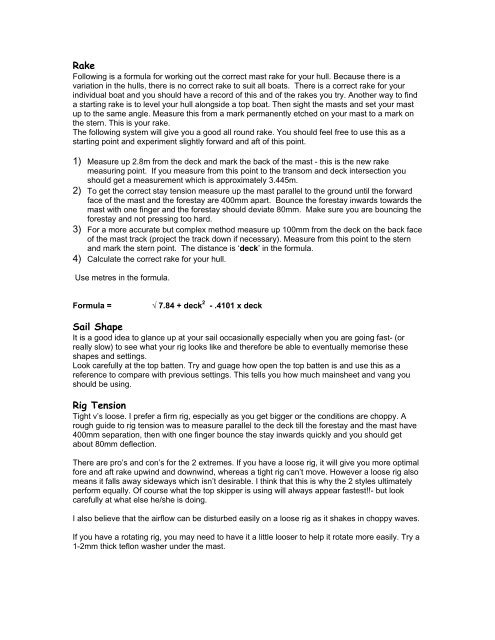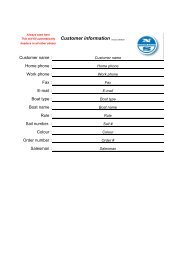Click here for a Starling Tuning Guide - North Sails
Click here for a Starling Tuning Guide - North Sails
Click here for a Starling Tuning Guide - North Sails
You also want an ePaper? Increase the reach of your titles
YUMPU automatically turns print PDFs into web optimized ePapers that Google loves.
Rake<br />
Following is a <strong>for</strong>mula <strong>for</strong> working out the correct mast rake <strong>for</strong> your hull. Because t<strong>here</strong> is a<br />
variation in the hulls, t<strong>here</strong> is no correct rake to suit all boats. T<strong>here</strong> is a correct rake <strong>for</strong> your<br />
individual boat and you should have a record of this and of the rakes you try. Another way to find<br />
a starting rake is to level your hull alongside a top boat. Then sight the masts and set your mast<br />
up to the same angle. Measure this from a mark permanently etched on your mast to a mark on<br />
the stern. This is your rake.<br />
The following system will give you a good all round rake. You should feel free to use this as a<br />
starting point and experiment slightly <strong>for</strong>ward and aft of this point.<br />
1) Measure up 2.8m from the deck and mark the back of the mast - this is the new rake<br />
measuring point. If you measure from this point to the transom and deck intersection you<br />
should get a measurement which is approximately 3.445m.<br />
2) To get the correct stay tension measure up the mast parallel to the ground until the <strong>for</strong>ward<br />
face of the mast and the <strong>for</strong>estay are 400mm apart. Bounce the <strong>for</strong>estay inwards towards the<br />
mast with one finger and the <strong>for</strong>estay should deviate 80mm. Make sure you are bouncing the<br />
<strong>for</strong>estay and not pressing too hard.<br />
3) For a more accurate but complex method measure up 100mm from the deck on the back face<br />
of the mast track (project the track down if necessary). Measure from this point to the stern<br />
and mark the stern point. The distance is ‘deck’ in the <strong>for</strong>mula.<br />
4) Calculate the correct rake <strong>for</strong> your hull.<br />
Use metres in the <strong>for</strong>mula.<br />
Formula = √ 7.84 + deck 2 - .4101 x deck<br />
Sail Shape<br />
It is a good idea to glance up at your sail occasionally especially when you are going fast- (or<br />
really slow) to see what your rig looks like and t<strong>here</strong><strong>for</strong>e be able to eventually memorise these<br />
shapes and settings.<br />
Look carefully at the top batten. Try and guage how open the top batten is and use this as a<br />
reference to compare with previous settings. This tells you how much mainsheet and vang you<br />
should be using.<br />
Rig Tension<br />
Tight v’s loose. I prefer a firm rig, especially as you get bigger or the conditions are choppy. A<br />
rough guide to rig tension was to measure parallel to the deck till the <strong>for</strong>estay and the mast have<br />
400mm separation, then with one finger bounce the stay inwards quickly and you should get<br />
about 80mm deflection.<br />
T<strong>here</strong> are pro’s and con’s <strong>for</strong> the 2 extremes. If you have a loose rig, it will give you more optimal<br />
<strong>for</strong>e and aft rake upwind and downwind, w<strong>here</strong>as a tight rig can’t move. However a loose rig also<br />
means it falls away sideways which isn’t desirable. I think that this is why the 2 styles ultimately<br />
per<strong>for</strong>m equally. Of course what the top skipper is using will always appear fastest!!- but look<br />
carefully at what else he/she is doing.<br />
I also believe that the airflow can be disturbed easily on a loose rig as it shakes in choppy waves.<br />
If you have a rotating rig, you may need to have it a little looser to help it rotate more easily. Try a<br />
1-2mm thick teflon washer under the mast.






